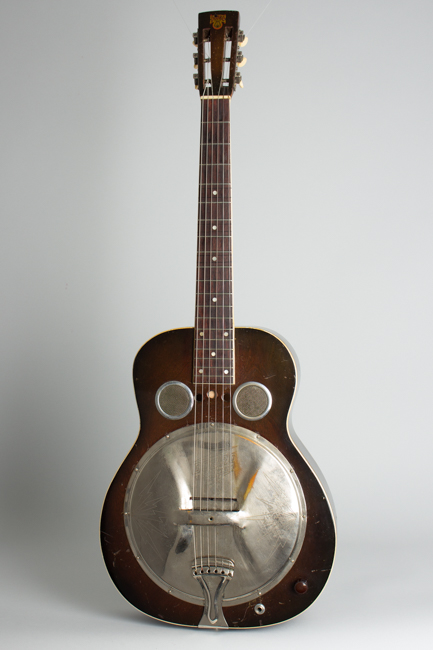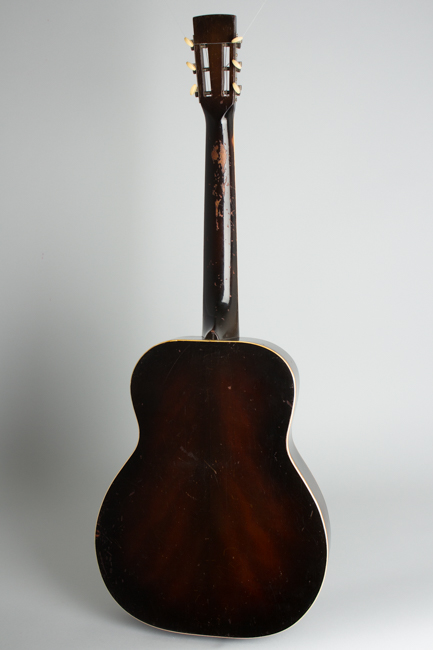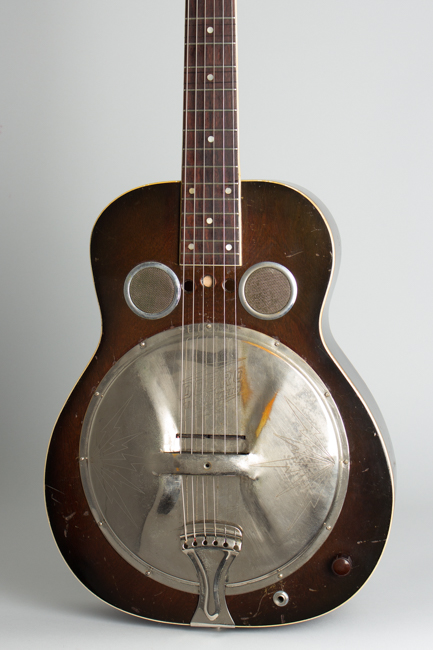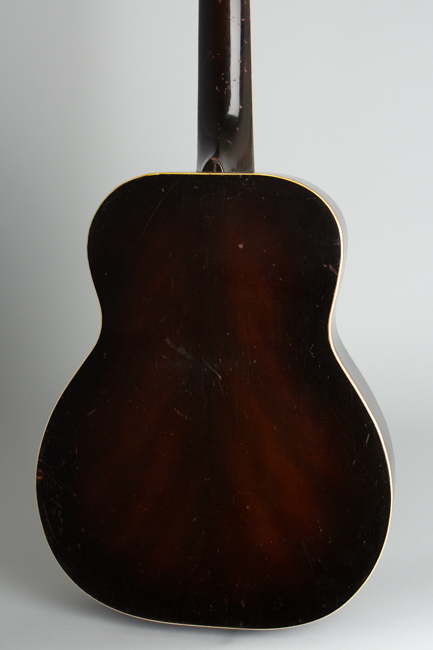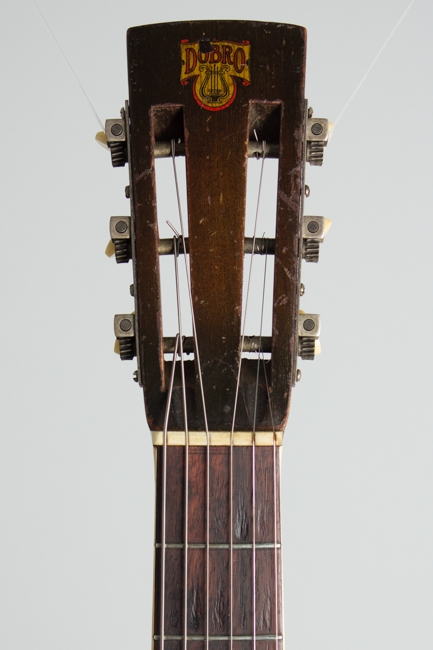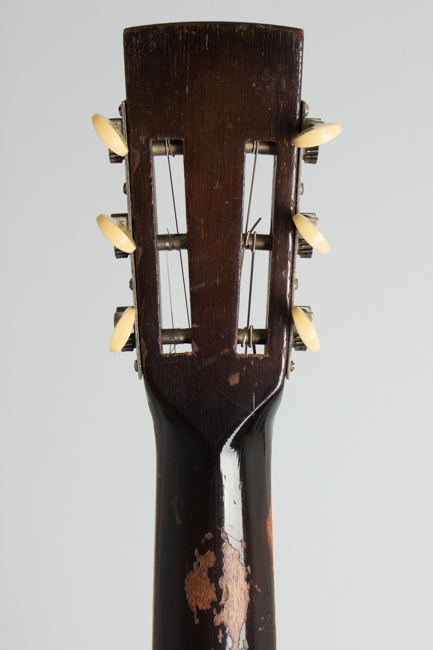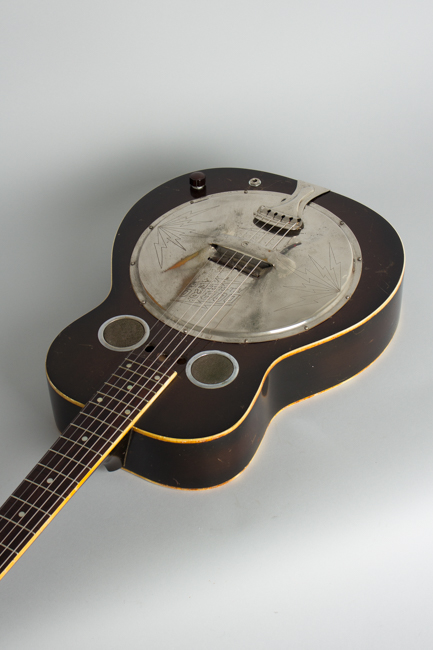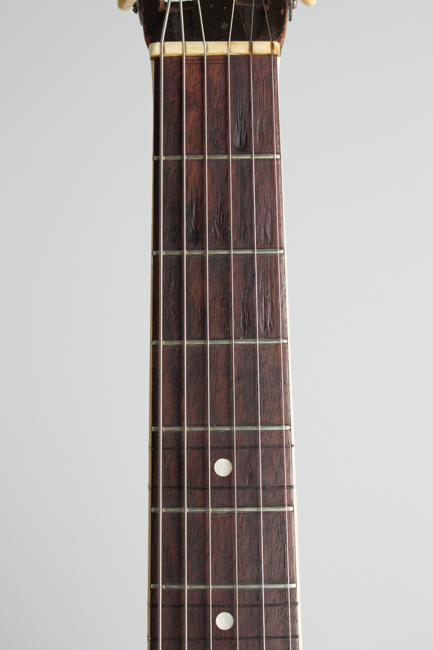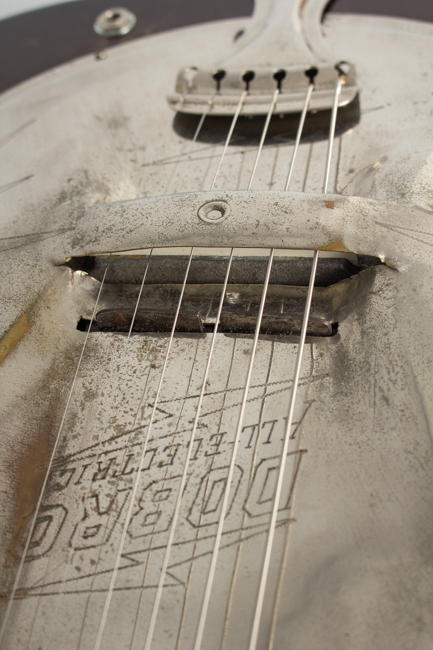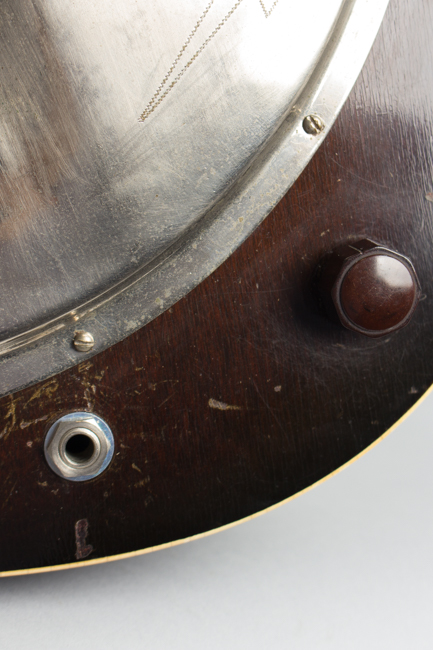Dobro All-Electric Hollow Body Electric Guitar (1934)
This item has been sold.
Item # 7493
Prices subject to change without notice.
Dobro All-Electric Model Hollow Body Electric Guitar (1934), made in Los Angeles, serial # 7813, brown lacquer finish, laminated wood body, mahogany neck with, black hard shell case.
The Dobro "All Electric" is one of the least known of the very early electric Spanish guitars of the 1930s, but in many ways one of the most advanced. It is also, like most early Spanish-style electrics, extremely rare. Dobro was not kidding with the name -- although it has a fairly large and mostly hollow body, this guitar has virtually no acoustic properties. It is a specific electric design and not a conversion of an existing acoustic instrument, although the coverplate/pickup assembly looks like it was designed so it could theoretically be assembled to any Dobro guitar.
At first glance the All-Electric looks rather like the standard Dobro with a bound mahogany body and screened-over sound holes in the upper bout. The large central coverplate is the giveaway, as it has no holes and is engraved "All Electric" with attendant lightning bolts. Two pickup blades rise discreetly through a slot in the coverplate just ahead of the bridge, one under the three bass strings and one under the treble. Underneath this, the pickup unit is mounted to a massive heavy aluminum casting that fits in the spot otherwise occupied by the Dobro cone. This makes the guitar quite heavy, even by resonator standards. This 1934 model is a second variation; the earliest 1933 models were somewhat different, with a slanted pickup and an integral tailpiece mounted directly to the bridge. There is a single volume control mounted on the face.
The pickup Dobro used on these first electrics has its own story. Up in Seattle, partners Paul Tutmarc and Arthur Stimson developed an electromagnetic pickup that contained a horseshoe-shaped magnet positioned horizontally, contained entirely within the body of the instrument instead of exposed as on the contemporary Rickenbacker design. It featured of two coils placed side by side, each at one end of the horseshoe magnet. Blades ran from the magnet poles up through the coils up toward the strings.
While Tutmarc started building electric Hawaiian guitars in Seattle in the 1930s to sell himself under the Audiovox brand name, Art Stimson traveled down to Los Angeles and cashed in on his labors more directly. Stinson sold their joint pickup design -- without Tutmarc's permission -- to the Dobro company for the seemingly paltry sum of $600. In 1932-3 at the heart of the Depression, that figure meant a lot more than it seems like today!
Dobro then adapted the Tutmarc/Stimson pickup -- designed for a solid-body lap steel -- into the All-Electric. Very few were actually built; the All-Electric was introduced in 1933 and out of production by late in 1934. There was simply no market for these early Spanish electric guitars; Rickenbacker concentrated on Hawaiian instruments and was able to survive, if just barely at first.
Despite its market failure, this is a very practical guitar by the standards of early electric instruments. The sound is much more akin to a later 1950s electric guitar than the more standard amplified instruments of the 1930s; the Stinson pickup mounted to a solid aluminum block gives a much brighter tone than most period designs. The guitar also features a "modern" 14-fret neck joint, and the neck itself has a shallow (back to front) "C" profile, not unlike many Gibson necks from the early 1960s.
According to a later interview with John Dopyera, all but one of these guitars were returned to the factory for refunds because nobody understood how to use them. Only a very few are known to exist today, which is rather a shame because they really are a very usable guitar in the our fully electric age. This example is relatively well-worn but is still a great-playing and sounding guitar, as well as an amazingly cool piece of electric guitar history.
Overall length is 37 3/4 in. (95.9 cm.), 14 5/16 in. (36.4 cm.) wide at lower bout, and 3 3/8 in. (8.6 cm.) in depth, measured at side of rim. Scale length is 24 3/4 in. (629 mm.). Width of nut is 1 3/4 in. (44 mm.).
This very rare instrument has seen a decent amount of wear and repair but remains fully functional, plays well, and actually sounds amazingly modern. The finish shows dings, scuffs, and scrapes overall with some heavier wear to the back of the neck, where there are larger spots of lacquer worn away. The binding on the body edges shows shrinkage, some discoloration, and numerous small cracks, but has not crumbled, and no areas are missing. The neck binding has a few splits but is largely intact. The Dobro decal has one spot flaked off the upper edge.
The neck was reset at some point; the work is not the neatest, but the resulting angle is excellent. There is currently a contoured bone saddle fitted to the massive cast metal pickup mounting plate that takes the place of the standard Dobro cone; the saddle was likely originally maple. The frets appear to be original and are in surprisingly good shape considering the overall condition of the instrument. The fingerboard has some odd lateral cuts across it and through the binding at the 5th, 7th, and 9th frets, which look like the remains of a long-ago attempt to possibly add some sort of bar inlay. This procedure was apparently abandoned and the lines filled, but they are still visible.
The rare engraved "All Electric" coverplate shows a decent amount of scuffing and minor corrosion; some plating is worn away from picking in the obvious spots. There are filled holes around the plate rim; it looks like the plate itself has been slightly re-located over time for reasons unknown. The early pickup remains intact but some of the wiring has been replaced including the jack and volume pot. The tuners and strap button are modern repros; the other hardware appears original. Despite what would appear to be a rather checkered past, this very early electric Spanish guitar remains an excellent-playing instrument as well as an amazing piece of history. Very Good Condition.
The Dobro "All Electric" is one of the least known of the very early electric Spanish guitars of the 1930s, but in many ways one of the most advanced. It is also, like most early Spanish-style electrics, extremely rare. Dobro was not kidding with the name -- although it has a fairly large and mostly hollow body, this guitar has virtually no acoustic properties. It is a specific electric design and not a conversion of an existing acoustic instrument, although the coverplate/pickup assembly looks like it was designed so it could theoretically be assembled to any Dobro guitar.
At first glance the All-Electric looks rather like the standard Dobro with a bound mahogany body and screened-over sound holes in the upper bout. The large central coverplate is the giveaway, as it has no holes and is engraved "All Electric" with attendant lightning bolts. Two pickup blades rise discreetly through a slot in the coverplate just ahead of the bridge, one under the three bass strings and one under the treble. Underneath this, the pickup unit is mounted to a massive heavy aluminum casting that fits in the spot otherwise occupied by the Dobro cone. This makes the guitar quite heavy, even by resonator standards. This 1934 model is a second variation; the earliest 1933 models were somewhat different, with a slanted pickup and an integral tailpiece mounted directly to the bridge. There is a single volume control mounted on the face.
The pickup Dobro used on these first electrics has its own story. Up in Seattle, partners Paul Tutmarc and Arthur Stimson developed an electromagnetic pickup that contained a horseshoe-shaped magnet positioned horizontally, contained entirely within the body of the instrument instead of exposed as on the contemporary Rickenbacker design. It featured of two coils placed side by side, each at one end of the horseshoe magnet. Blades ran from the magnet poles up through the coils up toward the strings.
While Tutmarc started building electric Hawaiian guitars in Seattle in the 1930s to sell himself under the Audiovox brand name, Art Stimson traveled down to Los Angeles and cashed in on his labors more directly. Stinson sold their joint pickup design -- without Tutmarc's permission -- to the Dobro company for the seemingly paltry sum of $600. In 1932-3 at the heart of the Depression, that figure meant a lot more than it seems like today!
Dobro then adapted the Tutmarc/Stimson pickup -- designed for a solid-body lap steel -- into the All-Electric. Very few were actually built; the All-Electric was introduced in 1933 and out of production by late in 1934. There was simply no market for these early Spanish electric guitars; Rickenbacker concentrated on Hawaiian instruments and was able to survive, if just barely at first.
Despite its market failure, this is a very practical guitar by the standards of early electric instruments. The sound is much more akin to a later 1950s electric guitar than the more standard amplified instruments of the 1930s; the Stinson pickup mounted to a solid aluminum block gives a much brighter tone than most period designs. The guitar also features a "modern" 14-fret neck joint, and the neck itself has a shallow (back to front) "C" profile, not unlike many Gibson necks from the early 1960s.
According to a later interview with John Dopyera, all but one of these guitars were returned to the factory for refunds because nobody understood how to use them. Only a very few are known to exist today, which is rather a shame because they really are a very usable guitar in the our fully electric age. This example is relatively well-worn but is still a great-playing and sounding guitar, as well as an amazingly cool piece of electric guitar history.
Overall length is 37 3/4 in. (95.9 cm.), 14 5/16 in. (36.4 cm.) wide at lower bout, and 3 3/8 in. (8.6 cm.) in depth, measured at side of rim. Scale length is 24 3/4 in. (629 mm.). Width of nut is 1 3/4 in. (44 mm.).
This very rare instrument has seen a decent amount of wear and repair but remains fully functional, plays well, and actually sounds amazingly modern. The finish shows dings, scuffs, and scrapes overall with some heavier wear to the back of the neck, where there are larger spots of lacquer worn away. The binding on the body edges shows shrinkage, some discoloration, and numerous small cracks, but has not crumbled, and no areas are missing. The neck binding has a few splits but is largely intact. The Dobro decal has one spot flaked off the upper edge.
The neck was reset at some point; the work is not the neatest, but the resulting angle is excellent. There is currently a contoured bone saddle fitted to the massive cast metal pickup mounting plate that takes the place of the standard Dobro cone; the saddle was likely originally maple. The frets appear to be original and are in surprisingly good shape considering the overall condition of the instrument. The fingerboard has some odd lateral cuts across it and through the binding at the 5th, 7th, and 9th frets, which look like the remains of a long-ago attempt to possibly add some sort of bar inlay. This procedure was apparently abandoned and the lines filled, but they are still visible.
The rare engraved "All Electric" coverplate shows a decent amount of scuffing and minor corrosion; some plating is worn away from picking in the obvious spots. There are filled holes around the plate rim; it looks like the plate itself has been slightly re-located over time for reasons unknown. The early pickup remains intact but some of the wiring has been replaced including the jack and volume pot. The tuners and strap button are modern repros; the other hardware appears original. Despite what would appear to be a rather checkered past, this very early electric Spanish guitar remains an excellent-playing instrument as well as an amazing piece of history. Very Good Condition.
